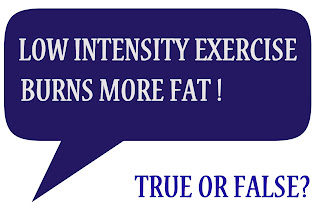Are you a treadmill user? Elliptical user? Stationary bike user? All of these types of machines typically have a "fat-burning-zone" setting, and many people click the setting...expect to see results...and end up progressively frustrated at the lack of results they ultimately experience. I can't count how many times I've heard about it. Why aren't these people actually burning the fat they want the most to burn, and getting in shape as desired? After all, it's a "fat-burning-zone" setting...so isn't that setting going to be the way to burn off the fat effectively and efficiently? In short...no. Not at all. It's essentially just a marketing tactic, and unfortunately it works and it sells. Here's a quick breakdown of the myth of the fat-burning-zone setting.
The phrase "fat burning zone" (sometimes called a "cardio zone," etc...something along those lines) is really just describing the intensity of a workout. The intensity of your workout determines the fuel source your body will use for energy needed to exercise. (See this post about exercise metabolism & energy to understand the three systems your body uses for energy - and for what types of exercise the different systems are or are not used.) Regardless of what we're doing, our bodies use fat and carbohydrate calories to power activity. The intensity of our workouts determines the RATIO of fat calories vs carbohydrate calories used (burned) to power activity. In the most basic sense...your body burns more fat calories RELATIVE to carb calories at lower intensities of exercise, and progressively burns more carbohydrate calories RELATIVE to fat calories as the intensity of your workout increases. As such, the "fat-burning-zone" setting on a treadmill, elliptical, etc is truly just a setting to promote a low intensity workout. (So...wouldn't that be right? Again, NO. ;) Let's continue...)
Although it is true that the body burns more FAT calories at lower intensities, you're talking about burning more fat calories RELATIVE to carbohydrate calories...overall, you'll still be burning far less calories altogether when compared with higher intensity exercise! And burning less calories overall will obviously NOT get you where you want to be. Yes, a higher intensity workout means your body will shift towards burning more carbohydrate calories relative to fat calories, but this is a ratio -- you will still be burning drastically MORE CALORIES OVERALL during a high intensity workout.
So what should you care more about? The whole "fat-burning-zone" term leads us to believe that's what's most important to weight loss/body composition change, so, is it?...or is burning more calories overall more important? Well, put simply, if the ratio was the most important thing (meaning burning more fat calories RELATIVE to carb calories)...then sitting still would be pretty darn effective since the body chooses fat calories for energy during low intensity activity. And we know that won't get the job done. ;) Case and point: the fat-burning-zone setting is a myth because it is referring ONLY to a relative ratio, and of course burning more calories overall is what is really going to start changing your body composition. You do still want to burn fat calories though, so how do you go about balancing out all this to make the MOST of the time invested in working out...getting the best results...sooner? High intensity INTERVAL training. (HIIT). And get yo' lift on - that too, obviously (hopefully obviously, anyway.) As the saying goes, what do you do for exercise? Lift. What do you do for "cardio?" Uhh, lift faster. ;) TBC on that front. In the meantime, hope that this clears up this treadmill setting myth, and you can be one less person to fall victim to it at the gym.
1. Clark, Micheal, Scott Lucett, and Brian G. Sutton. NASM Essentials of Personal Fitness Training. 4th ed.
Philadelphia: Wolters Kluwer Health/Lippincott Williams & Wilkins, 2012.
